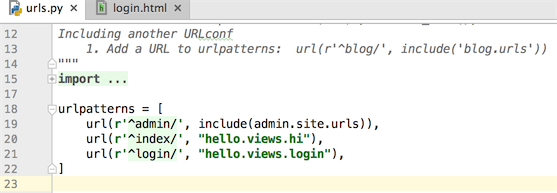Django框架首页和登录页分离操作示例
本文实例讲述了Django框架首页和登录页分离操作。分享给大家供大家参考,具体如下:
1.登录模板login.html
<!DOCTYPE html>
<html lang="en">
<head>
<meta charset="UTF-8">
<title>用户登录</title>
</head>
<body>
<form method="post">
<p>用户名:<input type="text" name="username"></p>
<p>密码:<input type="password" name="pwd"></p>
<p><input type="submit" value="提交"></p>
<hr>
</form>
<p> {{ result }}</p>
</body>
</html>
2.URL设置

url(r'^login/', "hello.views.login")
表示浏览器访问login,就指向hello应用下views文件下login方法
3.在login方法下响应login模板和完成登录功能
def login(request):
msg = {'result': ''}
if request.method == 'POST':
getUserName = request.POST.get('username')
getPwd = request.POST.get('pwd')
# 实例化UserLogin类
loginObj = UserLogin(getUserName,getPwd)
if loginObj.isLogin():
myReponse = HttpResponse("<script>self.location='/index'</script>")
myReponse.set_cookie('userlogin_username',getUserName,3600)
return myReponse
else:
msg['result'] = '用户名或密码错误'
myReponse = render_to_response("login.html", msg)
return myReponse
其中我们使用了UserLogin类,并用此类中的方法完成了用户是否已经登录的验证。
UserClass.py:
# coding:utf-8
class UserLogin:
userName = ''
pwd = ''
# 构造方法
def __init__(self,username,pwd):
self.userName = username
self.pwd = pwd
# 登录验证方法
def isLogin(self):
if self.userName == 'jack' and self.pwd == '123':
return True
else:
return False
在views.py中使用之前必须要引入:
from UserClass import UserLogin
表示从UserClass中导入UserLogin。
4.在login方法中,登录成功就跳转到了首页,首页显示登录用户名
<!DOCTYPE html>
<html lang="en">
<head>
<meta charset="UTF-8">
<title>首页</title>
</head>
<body>
<h2>这是首页,当前登录用户是:{{ username }}</h2>
<p><a href="##" rel="external nofollow" >安装退出</a></p>
</body>
</html>
def hi(request):
msg = {'username':'游客'}
if request.COOKIES.get('userlogin_username') != None :
msg['username'] = request.COOKIES.get('userlogin_username')
myReponse = render_to_response("index.html",msg)
return myReponse
希望本文所述对大家基于Django框架的Python程序设计有所帮助。